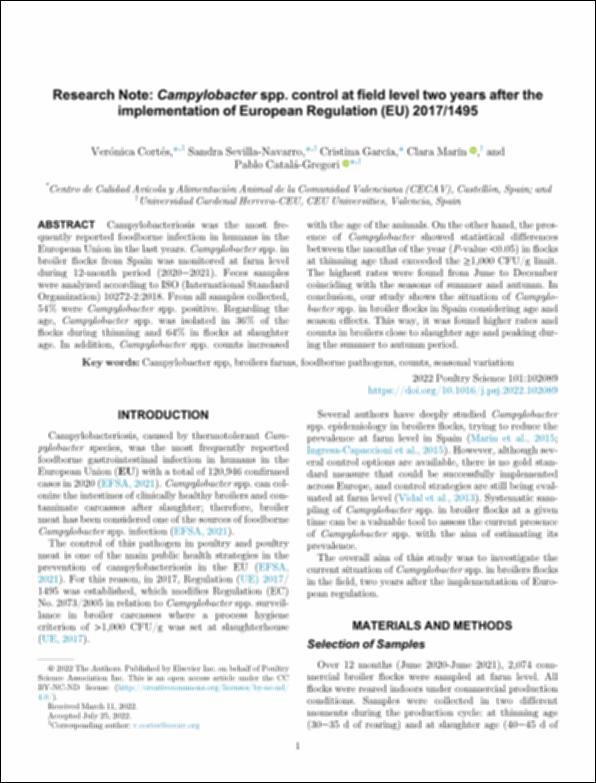Please use this identifier to cite or link to this item:
http://hdl.handle.net/10637/14261Research note: "Campylobacter" spp. control at field level two years after the implementation of European Regulation (EU) 2017-1495
| Title: | Research note: "Campylobacter" spp. control at field level two years after the implementation of European Regulation (EU) 2017-1495 |
| Other Titles: | "Campylobacter" spp. control at field level two years after the implementation of European Regulation (EU) 2017/1495 |
| Authors : | Cortés Moñiz, Verónica Sevilla Navarro, Sandra García Bover, Cristina Marín Orenga, Clara Catalá Gregori, Pablo |
| Keywords: | Farms.; Zoonosis.; Aves de corral - Enfermedades infecciosas.; Granjas.; Zoonoses.; Vibriosis.; Poultry - Communicable diseases. |
| Publisher: | Elsevier |
| Citation: | Cortés, V., Sevilla-Navarro, S., García, C., Marín, C. & Catalá-Gregori, P. (2022). Research note: "Campylobacter" spp. control at field level two years after the implementation of European Regulation (EU) 2017/1495. Poultry Science, vol. 101, i. 10 (oct.), art. 102089. DOI: https://doi.org/10.1016/j.psj.2022.102089 |
| Abstract: | Campylobacteriosis was the most frequently reported foodborne infection in humans in the European Union in the last years. Campylobacter spp. in broiler flocks from Spain was monitored at farm level during 12-month period (2020−2021). Feces samples were analyzed according to ISO (International Standard Organization) 10272-2:2018. From all samples collected, 54% were Campylobacter spp. positive. Regarding the age, Campylobacter spp. was isolated in 36% of the flocks during thinning and 64% in flocks at slaughter age. In addition, Campylobacter spp. counts increased with the age of the animals. On the other hand, the presence of Campylobacter showed statistical differences between the months of the year (P-value <0.05) in flocks at thinning age that exceeded the ≥1,000 CFU/g limit. The highest rates were found from June to December coinciding with the seasons of summer and autumn. In conclusion, our study shows the situation of Campylobacter spp. in broiler flocks in Spain considering age and season effects. This way, it was found higher rates and counts in broilers close to slaughter age and peaking during the summer to autumn period. |
| Description: | Este artículo se encuentra disponible en la siguiente URL: https://www.sciencedirect.com/science/article/pii/S0032579122003789 |
| URI: | http://hdl.handle.net/10637/14261 |
| Rights : | http://creativecommons.org/licenses/by-nc-nd/4.0/deed.es |
| ISSN: | 0032-5791. 1525-3171 (Electrónico) |
| Language: | es |
| Issue Date: | 12-Oct-2022 |
| Center : | Universidad Cardenal Herrera-CEU |
| Appears in Collections: | Dpto. Producción y Sanidad Animal, Salud Pública Veterinaria y Ciencia y Tecnología de los Alimentos |
Items in DSpace are protected by copyright, with all rights reserved, unless otherwise indicated.


